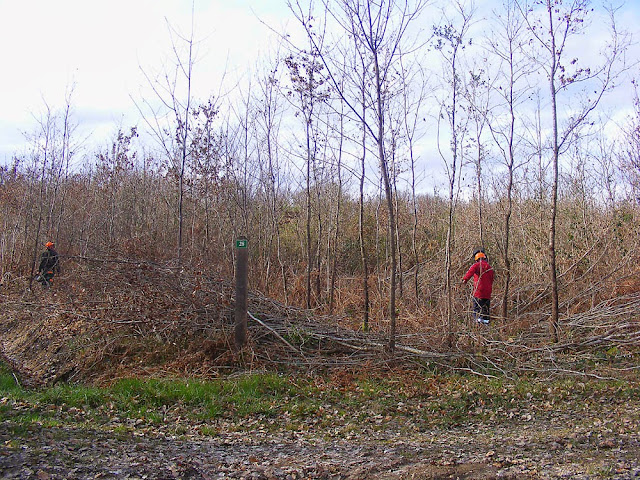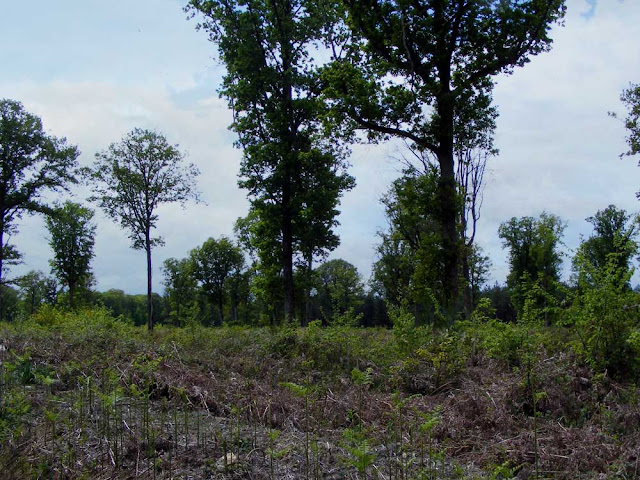 |
| A proud local sawmill owner, who has already supplied beams to Notre-Dame in the past and ready to do so again. |
Like all over France, owners of forests and sawmills in Indre et Loire (the Touraine Loire Valley) have mobilised, donating more than sixty trees for the reconstruction of the Notre-Dame de Paris roof carpentry. The trees, all between 150 and nearly 300 years old, will primarily come from forests at Amboise and Loches, but also Sainte Maure de Touraine and Orbigny.
 |
| Foresters trimming side branches. |
The family owned part of Forest of Amboise is among them. From the 1700 hectares they manage they are going to give two or three big very straight oaks of 250 - 300 centimetres circumference and 20 - 30 metres tall. Their foresters were out a couple of weeks ago to prepare the area for cutting these approximately 180 year old trees. Once identified a team went in and felled the chosen trees in 48 hours. The aim is to produce beams of a minimum of 14 metres long (some up to 18 metres) and a cross section of 50 centimetres.
 |
| Clearing space in new growth forest for selected trees to benefit. |
The co-operative Unisylva, with thirteen thousand members and four hundred thousand hectares of forest throughout France is doing likewise. Organised from their Central West office in Saint Avertin, sixty forest owners are ready to give 110 - 120 oaks to the reconstruction project. A hundred and sixty Unisylva members also own parcels in the Forest of Amboise, adding up to a total area of seventeen thousand hectares. Between them they have earmarked about forty trees as suitable for Notre-Dame.
 |
| A 200 year old oak tree in the forest. |
More than 1320 oaks are needed for the work, and very quickly after the fire in April 2019 the forestry sector declared itself ready to donate the trees to the Ministry of Culture. The sawmills too have said that they will prepare the wood free of charge. The forests around Loches are in a position to offer 10% of the timber needed for the project, and have previously proved their worth in providing timbers for other historic projects, such as the reconstruction of Lafayette's frigate, l'Hermione. Normally these most prestigious timbers would go to the wine barrel making companies, not just in France, but the world over. Less high quality timbers go for fuel as chips and logs in heating systems, and for more mundane domestic carpentry needs.
 |
| The tree marked with orange will be kept and other trees around it cleared to give it room to grow tall and straight. |
The trees must be felled before 15 March, because it is best done before the sap rises, and spring is already here in the Loire Valley. If they are felled at this time it means they will dry and be useable more quickly. They will be laid out to dry for 18 months before being used, so it is now or never if the new spire is to be started at the beginning of 2023 as planned. Each one of the trees has been individually identified and checked for diametre, height, quality and straightness before confirming that they will be felled. Their details have been entered onto a database with GPS co-ordinates. Once felled they will stay on the ground for a few days because a crane and a special convoy to transport them to the sawmill has to be organised.
 |
| A road through the Forest of Loches. |
Sessile Oaks make up a large proportion of the Forest of Loches and about thirty of them, with an average age of 200 years, have been chosen to go towards the new spire of Notre-Dame. The Forest of Loches is mostly State Forest, so directly managed by the National Office for Forests, but private owners are involved too in certain parcels. The foresters have had to find trees that will yield very straight timbers of 15 - 20 metres long, not such an easy task. These are absolutely top quality trees and the foresters are very proud to have produced something suitable for the most prestigious part of the cathedral. These trees were due to be felled anyway in the next few years, as the part of the forest they are in is earmarked for regeneration, with new oak seedlings taking their place.
 |
| These 6-8 metre beams are the largest the sawmill usually has to supply. |
I know, from talking to Rémi, the man in the first photo, that finding and harvesting the trees is not the difficult part. The real challenge is going to be transporting such long lengths of timber and manipulating them in the sawmill and on the construction site. The longest beam Rémi has ever previously sent out of the mill was twelve metres, and that was the very limit of the semi-trailer's capacity. It makes you wonder how the medieval builders managed it!
 |
| Manoeuvring logs in the sawmill yard. |
Twelve to eighteen thousand tonnes of wood is harvested annually from the Forest of Loches, and each of these trees for Notre-Dame weighs about 8 tonnes and is worth about €15 000. There are literally millions of trees in the forest, of which about a hundred thousand are more than 150 years old, up to about 360 years old. In a parcel that is regenerating there is about one seedling every 20 centimetres, or two hundred thousand per hectare. The removal of these big old trees will leave room for new young trees to get their chance.
 |
| This forestry parcel is being allowed to naturally regenerate. |
This old forest has been managed for timber and leisure for centuries. In the past its principle purpose was to provide good hunting grounds for the King, and wood for naval vessels. According to the foresters, the soil is ideal for Sessile Oak, and until recently, the weather too, with sufficient rainfall, evenly dispersed throughout the year. Now, with increasing periods of dry, which does not suit oak, they are beginning to experiment with trees from Mediterranean climates.
 |
| A peaceful forest ride (Fr. allée). |
Foresters are very aware that they are merely custodians, and part of a chain which includes their ancestors, and their successors. The trees will be cared for by six generations of foresters before they are felled. The forestry professionals say there is always a certain sadness at felling such majestic trees, but they are so proud they will be used in the reconstruction of such an important French building. Each of the beams they supply will be marked so they can be identified once up in the roof of the Cathedral.
 |
| Preparing to fell one of the trees in the Forest of Loches. Photo courtesy of Alain Biard. |
My friend Alain was lucky enough to be invited to be present at the felling of some of the Loches trees, and has kindly agreed for me to use some of his photos. He said it was an impressive thing to see, with a frisson of danger as you could imagine how easy it would be to have an accident. I am deeply envious! It was used as a teaching opportunity for a number of young forestry students and apprentices which we both agreed was very good to see.
 |
| The tree is clearly marked for felling. Photo courtesy of Alain Biard. |
 |
| Measuring the downed tree, with lots of students watching on. Photo courtesy of Alain Biard. |
We are also on Instagram, so check us out to see a regularly updated selection of our very best photos.

6 comments:
I see in the Nouvelle République newspaper that the Loir-et-Cher department is donating 37 big oaks to the Notre-Dame restoration. Some are coming from Marchenoir, not too far north of Blois.
Another fascinating post! Wow!
Very informative, as usual! I'd read a few days ago about forests in the Sarthe doing their bit for Notre Dame, and after reading your post I found a short video showing one tree being pruned and neatly felled. Apparently not all the trees the foresters had identified as suitable turned out to have the necessary usable length, or there might have been rot. The foresters stressed that this would be the experience of their professional lifetimes.
There is something comforting and re-assuring in knowing that trees that have come to the end of one phase of their existence will go on fulfilling a useful purpose for - let us hope - centuries to come: and will be replaced by new growth as well.
Something my forester regularly said was "Neither you, your son, your grandson.... nor your great-grandson will fell an oak that you plant.... "
How interesting, thank you. It is so good to know how people rally around when there has been a fire in a National Treasure and rebuilding is required.
Post a Comment